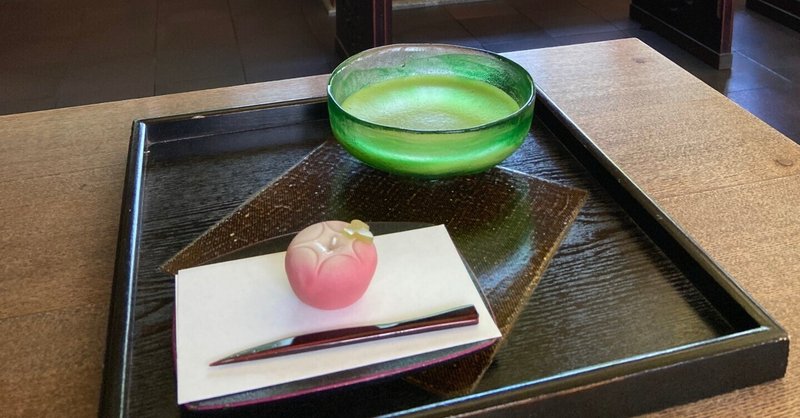
【~連載~静岡の歴史を学ぼう233】
※ この記事は「静岡移住計画Facebook 」に掲載されております。
季節を感じたくなったら、駿府城公園内、紅葉山庭園の立礼席へ。
季節の美しさ、そして茶道の奥深さを楽しみながら抹茶を頂きましょう。
Enjoying matcha in summer
夏に抹茶を堪能する
Even in an extremely hot summer, drinking matcha makes me feel so relaxed and calm.
本当に暑い夏でも、抹茶を飲むとリラックスして落ち着きます。
The best spot for me to enjoy matcha is Ryurei-seki (the tea room), Momijiyama Garden, in Sumpu Castle Park.
私にとって抹茶を楽しむのに一番の場所は駿府城公園の中にある紅葉山庭園の立礼席(ティールーム)です。

It is so hot outside; however, it is so comfortable inside the tea room.
外は大変暑いですが、ティールームの中は大変快適です。
The matcha was served in a flat, green-glazed glass bowl.
抹茶が平たい、緑のガラス製のお椀で出てきました。
It looks so cool.
とても涼し気です。

In summer, matcha is served in a flat bowl to provide a sense of coolness; on the other hand, it is served in a cylindrical-shaped bowl in winter to insulate the heat.
夏、抹茶は涼しさを感じさせるため、平らな形のお椀で供されます。一方冬には断熱のため、筒状の形のお椀で出されます。
"Provide a sense of coolness in the summer and warmth in the winter." (Sen no Rikyu, quoted from Urasenke homepage)
「夏は涼しく冬は暖かに」(千利休 裏千家ホームページより引用)
This is according to the Seven Rules in the Tea Ceremony defined by Sen no Rikyu, the tea master who developed the Way of Tea to perfection in the 16th century.
これは16世紀に茶道を大成させた大家である千利休が定めた七つの規則に従っています。
And for me, the shape of the bowl reminds me of the arrival of summer.
私にとっては、このお椀の形で夏の訪れを感じます。
Along with the matcha, wagashi, or Japanese sweet, is also served.
抹茶と共に、和菓子も出されます。

This wagashi represents morning glory, which is the symbol of Japanese summer because most Japanese have experienced planting their own morning glory flowers in their elementary school days.
この和菓子は朝顔を表しています。朝顔は日本の夏を象徴しています。
ほとんどの日本人が小学生時代に朝顔の栽培をした経験があるからです。

In addition, morning glories were an important part of summer for people in the Edo period.
それに、朝顔は江戸時代の人々にとって夏の重要な一部分でした。
Especially in the city of Edo, they enjoyed growing various kinds of mutated flowers using selective breeding.
特に江戸の街で人々は、品種改良を用いて様々な種類の変異した朝顔を楽しんでいました。

珍しい朝顔のコレクション本 いかに朝顔の栽培が人気だったか分かります

Look at this sweet so carefully.
この和菓子を注意してよく見て下さい。
It has a dewdrop in the center.
中央にしずくがあります。

This sweet's name is 'morai-mizu', which means 'given water'.
この和菓子の名前は「もらい水」です。
The dew reminds us of cooler weather in the morning haze.
その水滴が朝もやが立つ涼しげな天候を思い出させます。
It inspires me to recall the refreshing mornings of summer.
この和菓子を見たら、夏のさわやかな朝を思い浮かべます。
(参考資料)
裏千家ホームページ (日本語および英語)
この記事が気に入ったらサポートをしてみませんか?
